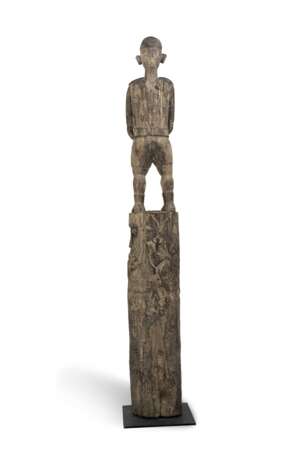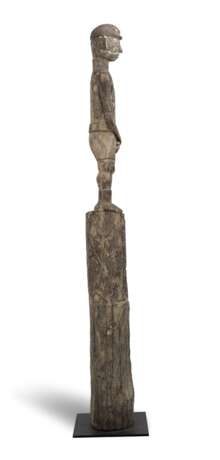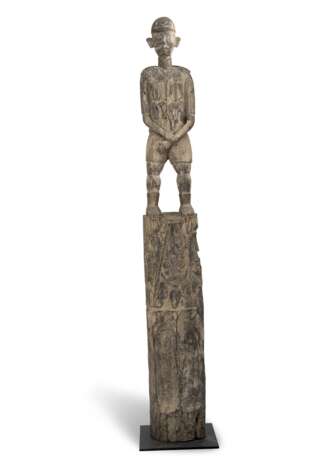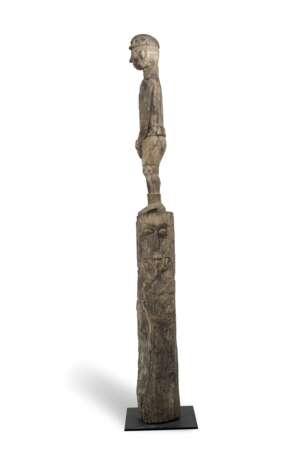ID 1218047
Lot 1530 | Schutzfigur ''hampatong'' aus Holz
Estimate value
€ 3 000 – 5 000
H. 220 cm ( o.S.)
Hampatong (patong: Statue) sind Statuen aus dauerhaftem Holz, die auf Borneo innerhalb der Dayak-Kulturen um die bewohnten und bewirtschafteten Bereiche als Schutz und Erinnerung errichtet werden. Sie grenzen die menschliche Sphäre von der Göttlichen (der Urwälder, Berge etc.) ab und halten Dämonen fern. Dieser hampatong ist eine Rarität, er weicht von den eher gängigen Ahnen-, Drachen- und Mutterfiguren deutlich ab. Aus einem Eisenholzstamm (belian) ist eine stehende vollplastische Figur herausgeschnitten, die eine detailgetreu dargestellte Uniform trägt. Wahrscheinlich handelt es sich um die Darstellung eines einheimischen Soldaten, der in der Zeit des Zweiten Weltkrieges rekrutiert war, um die japanische Besatzungsmacht zu bekämpfen. Für die Dayak, vor allen die kriegerischen Iban Sarawaks, ist der Wehrdienst in fremden Diensten ebenso „Kriegertum“ wie die traditionelle ritualisierte Stammesfehde (mit Kopfjagd). Die Figur steht auf einem teilweise kannelierten Sockel, der in tumpal-Dreiecke einbeschriebene Schreckmasken (hudoq) sowie Graburnen-Motive zeigt. Die tumpal und die Urne stehen für die Verbindung bzw. das Durchgreifen zwischen den Ebenen Unter- und Mittelwelt (Menschenwelt). Ferner lassen sich stilisierte Menschenformen und Büffel in nicht sicher interpretierbaren Handlungen und Zusammenhängen (wahrscheinlich Landwirtschaft und Ernte) erkennen. Die malaiischen Iban-Dayak haben sich u.a. durch die Bekämpfung der japanischen Invasionsmacht von West-Borneo einen Namen gemacht. Die japanische Besetzung Borneos fand 1942 im Westen und Südwesten Borneos durch Truppen des Japanischen Kaiserreichs während des Pazifikkriegs im Zweiten Weltkrieg statt. 1945 starteten die Alliierten die Operation "Semut", bei der mehrere britische Kommandosoldaten mit dem Fallschirm über Borneo absprangen, um Kontakt mit den indigenen Völkern aufzunehmen und sie zum Widerstand gegen die Japaner zu bewegen. Die Heimatregion der hieran maßgeblich beteiligten Iban ist der Nordwesten Borneos, insbesondere der malaysische Bundesstaat Sarawak. Dort stellen sie heute die größte Volksgruppe dar. The Malay Iban-Dayak have made a name for themselves by fighting the Japanese invasion of West Borneo, along with others. The Japanese occupation of Borneo took place in 1942 in the west and south-west of Borneo by troops of the Japanese Empire during the Pacific War in the Second World War. In 1945, the Allies launched Operation Semut, in which several British commandos parachuted over Borneo to make contact with the indigenous peoples and persuade them to resist the Japanese. The home region of the Iban, who played a key role in this, is the north-west of Borneo, particularly the Malaysian state of Sarawak. They are the largest ethnic group there today.
Aus einer alten deutschen Privatsammlung, seit den 1950er Jahren gesammelt - Minim. Altersspuren, partiell best. und Altersrisse, montiert
| Auction house category: | Ethnographic tribal art |
|---|
| Auction house category: | Ethnographic tribal art |
|---|
| Address of auction |
Nagel Auktionen GmbH Neckarstrasse 189 - 191 70190 Stuttgart Germany | ||||||||||||||
|---|---|---|---|---|---|---|---|---|---|---|---|---|---|---|---|
| Preview | |||||||||||||||
| Phone | +49 (0)711 649 690 | ||||||||||||||
| Fax | +49 (0)711 649 69696 | ||||||||||||||
| Buyer Premium | 29,5% | ||||||||||||||
| Conditions of purchase | Conditions of purchase | ||||||||||||||
| Business hours | Business hours
|






